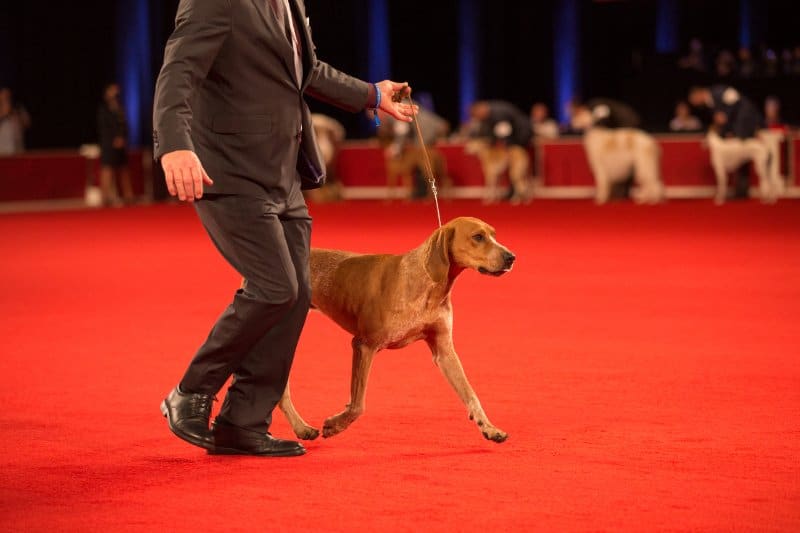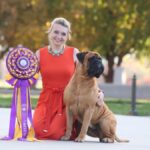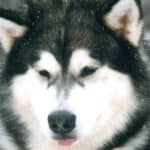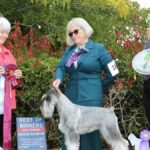Awareness and management of ring space is an important part of handling your dog in conformation. This includes physical obstacles in the ring such as tent poles or the table, footing, the other dogs and handlers in the ring, and thinking about how the judge can best view your dog.
Dealing with physical obstacles is relatively simple: don’t put your dog behind them. If your dog is stacked behind the table, it doesn’t matter how gorgeous he looks, because the judge won’t be able to get a good view. Instead, set your dog up in front of the table or to either side. At indoor shows with rings that aren’t fully matted, it is best to set up to either side of the table so that your dog can still be on the matting.
At outdoor shows with tent poles, the poles and associated ropes need to be taken into consideration. Stack your dog so that he is in between poles to give the judge a clear view. Depending on the size of your dog and the dogs around you, this may mean sharing a gap or taking up a whole one. This can result in some jockeying for space. After the dogs are lined up at the start of judging, pay attention to how many dogs are in front of you and where you need to stop in order to claim part of a gap between tent poles.
Footing varies widely from show to show, especially when competing outdoors. Most facilities are not meticulously dragged and rolled, and thus are not perfectly flat. Watch the breeds that go in before you to see if there are any dips or holes in your ring. These dips are not always easily visible because mowers can leave all of the grass at the same height even if the actual ground is several inches lower in spots. Many dogs respond to dips in the ground by breaking their gait, or sometimes even stumbling.
If you recognize a problem area that has caused multiple dogs to break, try to avoid that part of the ring with your own dog by making a smaller or wider circle as needed. If there is a particularly bad hole in the middle of the ring, judges will often alter their down and back so that the dogs don’t go through it. And keep an eye out for those tent poles! I have seen many handlers execute a last-second leap over a tent stake, and have had to do some creative leash handling myself when my dog and I each went to opposite sides of a pole.
When showing indoors, keep your dog on the mat while gaiting so that he doesn’t slip and mess up his movement—or worse yet, injure himself. This may require you to run off the mat right next to the ring gating. For handlers with small or slow moving dogs this won’t cause a problem, but for those who need to run to keep up with their dogs, shoes with a good grip are a must.
Many indoor shows are on smooth cement, and even some carpeting can be slick if you don’t have shoes with a good sole. While carpeting doesn’t have the potential uneven spots of a lawn, carpeted rings do often have odd bits here and there. Many ballrooms have small metal covers that are probably for electrical purposes or to secure dividers when the room is broken up into multiple smaller rooms. These metal plates sometimes make a noise when stepped on, which could startle your dog. One year showing at the Garden, there was a corner of the Belgian Tervuren ring that had a loose board that would drop down an inch or so and clunk when stepped on. After the first go-around, most of the handlers started to cut that corner short to avoid the loose board.
We always want the judge to be seeing our dog looking its best. For some dogs, the angle may not matter, but for others, the profile may be a “better side” than the front or vice versa. Pay attention to what the judge is seeing. Obviously for the individual exam, the judge is going to want to see a profile, but beyond that it is often up to the handler. After the down and back, angle your dog whichever way makes him look the best, and when standing in the lineup while other dogs are examined, aim his best side toward the judge. If in a corner of the ring, I like to set my dog up on the diagonal so that the line of dogs curves at the corner rather than making a right angle. The presents anyone from getting lost in the corner, especially me.
No matter how much we pay attention to the stationary challenges that each ring possesses, there are still any number of dogs and handlers whose behavior we can’t predict or control. As well as looking out for your own dog and making sure that she is visible to the judge and looks her best, I encourage you to be considerate of the other dogs and handlers in the ring as well. This comes down to two things: having enough space, and not wasting the space you have.
Every dog needs some space in the lineup, and the amount of space required will vary from dog to dog. Dogs that are hand stacked and presented like a Pointer need enough room for the dog’s head and tail to be stretched out, and dogs that are baited from in front, like a Collie, need enough room for the handler to stand far enough away that the dog isn’t looking up at an awkward angle.
Some dogs may be comfortable with other dogs close around them, while others are happiest with some personal space. Pay attention, and don’t be obnoxious. When gaiting around the ring, determine where the dog in front of you is going to stop and think about how much space you need. There is no excuse for running up on someone else’s dog, and it could result in a fight depending on the personalities involved. If the handler behind you persists in invading the space that you and your dog need, stop earlier on the go-around to claim extra space so that you have room to move up if needed. You can also ask them to give you more room.
At the same time that handlers should be allowing each dog to have enough room in the ring, spacej also shouldn’t be wasted. There is no need for the first dog in line to have ten feet of space between them and the ring gating. All of that space is wasted, causing more dogs at the end of the line to be pushed onto another side of the ring. While not necessarily a problem for the dogs, I think most judges appreciate being able to look at the entire entry at once when possible. This is especially irritating when it is raining or extremely hot and sunny. Be fair. Personally, I find that being already lined up with the next side of the ring can be an advantage, because my dog can get into her full stride quicker without needing to make a turn immediately after starting.
My biggest pet peeve when it comes to managing ring space is when a handler sets his or her dog up deeper into the ring so that it is popped out of the lineup. Once one person does it, the dogs behind them have to at least line up even with that dog or be standing in the background, and by the time everyone has one-upped the dog in front of them, half the dogs are standing in the middle of the ring and the judge is tripping over the placement signs to walk down the line. It is ridiculous to watch the Group ring when a judge says for the dogs to go around and the entire line has to back up ten or twelve feet to get to the ring gating!
I am sure that this complaint will fall mostly on deaf ears, because, “I have to make sure my dog is seen.” Isn’t there a more artful way of doing that than standing out of line, and do we really think so lowly of judges that we believe that is the only way to get noticed? Make a straight line and stay in it. If your dog is in good condition, showed well on the individual, and is presented favorably in the lineup, the judge will reward you.
When it comes down to it, our job as handlers is to be the navigator for our dogs. We chart the course around the ring, plan where to stop and stack, and maintain personal space between ourselves and the other teams. When everyone pays attention and is considerate of all the people, dogs, and environmental factors in the ring, our day goes smoothly and everyone has a positive experience.
From the Showsight Archives: October 2014 Issue. Click to subscribe.








